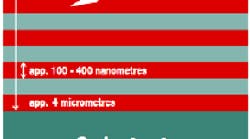Crediting “an optimized nanostructure” in its new universal coating formula, Oerlikon Balzers is promoting the Balinit Pertura recipe as a way to improve hardness and increase resistance to residual stresses, for high-performance solid-carbide drills.
Oerlikon Balzers develops coatings used to improve performance and service life of precision components, as well as of tools for machining metal and plastics, to enhance hardness and reduce friction and wear. For example, for drilling holes in steel, stainless steel, or cast iron; or if a part requires specialized bit geometries (deep hole, micro, step drilling, internal cooling, or external cooling), Balinit Pertura reportedly will improve abrasion resistance and extend tool life at moderate and high speeds.
The developer cited the problem of cracks that develop in multilayer coatings, tending to “wander along boundary lines” between layers approximately 100 to 400 nanometers thick. Because the new formulation has a tighter nanolayer construction (5 to 20 nanometers thick), crack propagation is significantly reduced, which leads to notably longer tool life, even in dry drilling or deep-hole drilling applications.
Improved abrasion resistance also means smoother chip evacuation, Oerlikon noted, in tough materials and non-standard holemaking tasks, as well as at reduced tool and machine stress levels. This also extends the life and performance of capital equipment. Productivity tests in steel at both moderate and high drilling speeds demonstrated 20-40% increases in the number of holes successfully complete. In cast iron, machining time to produce 500 holes was cut in half.
In addition to higher rates of productivity, the new coating helps to cut engineering and maintenance costs because of the reduced need for machine reconditioning. “Returning precision drilling tools to as-new conditions over a number of cycles extends cost efficiency,” the developer offered. Two recoating options are possible: In decoating, the worn coating is removed from the substrate, after which the new coating is applied to the appropriate surfaces. Overcoating – the less expensive alternative – consists in regrinding the worn tool only at the functional surfaces, after which the entire drill is coated again.








